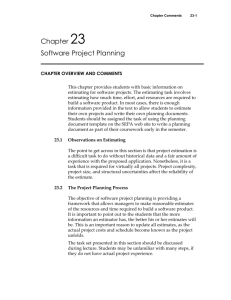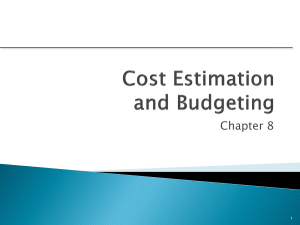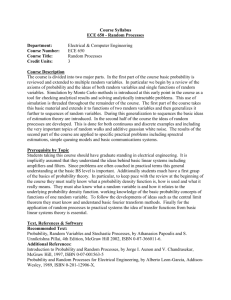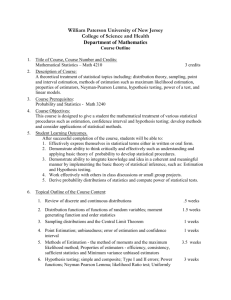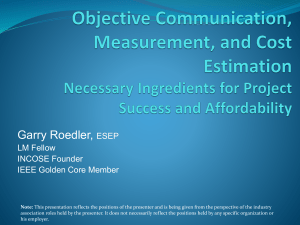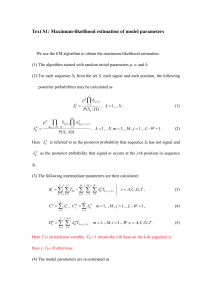SLIM-Estimate
advertisement
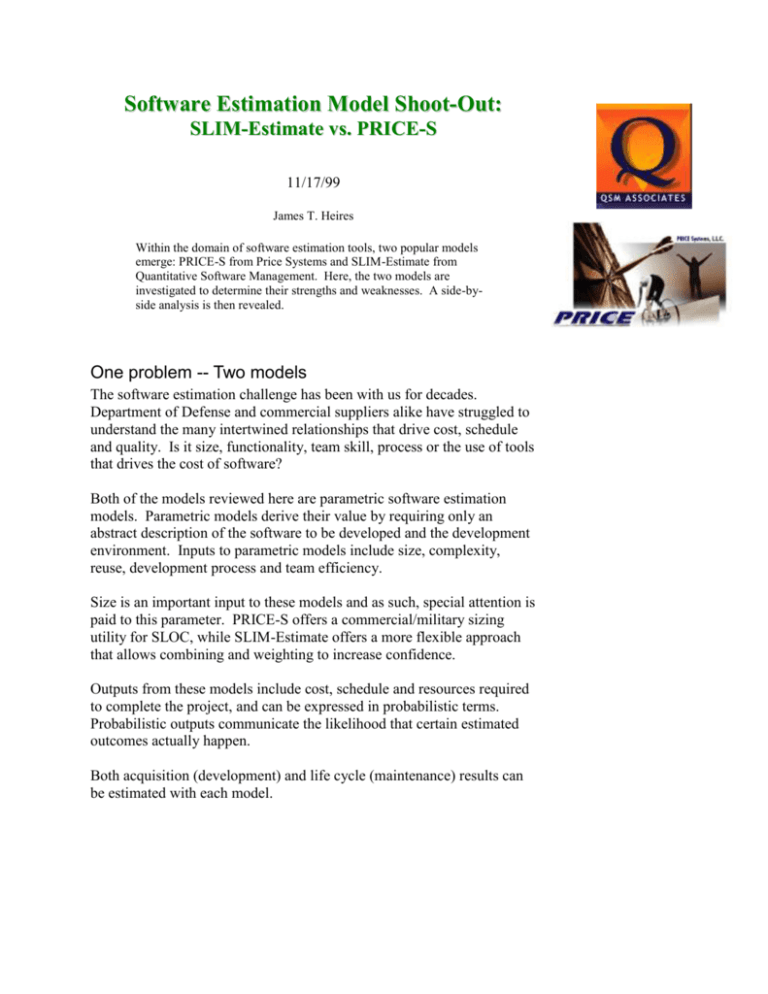
Software Estimation Model Shoot-Out: SLIM-Estimate vs. PRICE-S 11/17/99 James T. Heires Within the domain of software estimation tools, two popular models emerge: PRICE-S from Price Systems and SLIM-Estimate from Quantitative Software Management. Here, the two models are investigated to determine their strengths and weaknesses. A side-byside analysis is then revealed. One problem -- Two models The software estimation challenge has been with us for decades. Department of Defense and commercial suppliers alike have struggled to understand the many intertwined relationships that drive cost, schedule and quality. Is it size, functionality, team skill, process or the use of tools that drives the cost of software? Both of the models reviewed here are parametric software estimation models. Parametric models derive their value by requiring only an abstract description of the software to be developed and the development environment. Inputs to parametric models include size, complexity, reuse, development process and team efficiency. Size is an important input to these models and as such, special attention is paid to this parameter. PRICE-S offers a commercial/military sizing utility for SLOC, while SLIM-Estimate offers a more flexible approach that allows combining and weighting to increase confidence. Outputs from these models include cost, schedule and resources required to complete the project, and can be expressed in probabilistic terms. Probabilistic outputs communicate the likelihood that certain estimated outcomes actually happen. Both acquisition (development) and life cycle (maintenance) results can be estimated with each model. Software Estimation Model Shoot-out 02/05/16 SLIM-Estimate: Software LIfecycle Management 1 A General Empirical Solution to the Macro Software Sizing and Estimating Problem, Lawrence H. Putnam, IEEE Transactions on Software Engineering, July 1978, Vol. SE-4, No 4, pp. 345361. SLIM-Estimate is a macro-level, dynamic, graphical estimating model. Part of a family of quantitative software management products including SLIM-Control and SLIM-Metrics. SLIM-Estimate is based upon empirical data analysis work published by Larry Putnam1. Inputs to the model are organized in a logical, flexible format. Sizing can be entered using abstract terms or broken down into functions or modules2. The outputs from SLIM-Estimate are many and varied. A graphical staffing profile is based on an empirically derived Rayleigh curve3. This output is unique in that it is interactive. Once an initial solution has been derived, the user can study "what-if" scenarios such as: What if the customer wants additional functionality? What if we experience unplanned staff turnover? What if we spend more time in requirements capture? This interactive nature of SLIM-Estimate allows for powerful size/time/effort/quality trades early in project planning. 2 SLIM-Estimate sizing Fifty proprietary department of defense projects form the basis of the software equation upon which this model is based. This equation has since been calibrated with over 4500 projects from many application domains. The Putnam software cost equation is: Effort = B * Size3 / (PP * T4) 3 Where: SLIM-Estimate Staffing Profile Size = Lines of Code or function points to be developed B = Skills factor that depends upon size PP = Productivity Parameter from empirical data T = Schedule (time) 4 Watching the Detectives, Elvis Costello and the Attractions, produced by Nick Lowe, from the album My Aim is True (rc 0271), Rykodisc, 1977. Visible shivers running down my spine4 One can readily notice by the exponents in the above formula that a severe effort penalty is given to increasing the size or shortening the schedule. Another powerful SLIM-Estimate feature is the ability to visually compare historical data to the current estimate5. Showing actual performance from similar projects next to the current estimate and industry trends provides much needed justification. 5 2 Similar-to comparison James T. Heires Software Estimation Model Shoot-out 02/05/16 PRICE-S If you need a second opinion as you seem to do these days6 6 I want you, Elvis Costello and the Attractions, produced by Nick Lowe, from the album Blood and Chocolate (rcd 20282), Rykodisc, 1986. PRICE-S is a parametric software estimation model originally developed at RCA in the late 1970's. One of a family of cost estimation tools including PRICE-H (hardware) and PRICE-M (electronic components). PRICE-S is a process-oriented model that was validated with empirical data. This model has separate sizing modes for commercial and military software applications. Acquisition and lifecycle estimates are carried out as independent activities, but with data dependencies. 7 PRICE-S Software Development and Support Cost Model User Guide, PRICE Systems, Mt. Laurel, NJ, 1997. The PRICE-S software cost equation is: Effort = (ePROFAC * [VOL f (PROFAC)]) / 10007 Where: PROFAC = Productivity factor from empirical data VOL = Software volume (a function of size) The input format consists of an estimating breakdown structure to assist decomposing a large system into its component parts8. Users familiar with PRICE-H will be right at home with the PRICE-S interface. Reused code is characterized as either purchased or furnished, while developed code is characterized separately. 8 PRICE-S Estimating Structure The primary PRICE-S output is a tabular report format. However, several graphs are also available9. In addition, the probabilistic report format can be shown as either a frequency distribution or a probability distribution. This report can also be exported to an ASCII text file for importing to other tools. 9 3 PRICE-S Staffing Profile James T. Heires Software Estimation Model Shoot-out 02/05/16 Side-by-Side comparison It's the stupid details that my heart is aching for6 Performance Stronger for User Interface SLIM-Estimate Published model Interactive and fast IT domain Simple economic model Graphical, interactive Easy to use, intuitive PRICE-S Proprietary model Good, but Monte Carlo is slow Real-time domain Detailed economic model Graphical, batch feel Terminology, interface requires training SLOC Function Points N/A 17 other size units, multiple methods New-never designed code N/A Modified code Reused code Application type (9 predefined) Waterfall assumed** SLOC Function Points Predictive Object Points N/A New-never designed code New-already designed code Modified code Reused code Platform (12 predefined) 5 choices available Schedule (overall) Effort Cost Staffing Reliability Tools/methods Technical difficulty (14 factors) Personnel (9 factors) Reuse environment Productivity (PI)** Schedule (by phase) N/A N/A N/A N/A Tools Technical difficulty (6 factors) Personnel (6 factors) N/A Productivity by CSC/CSCI (PROFAC)** Computed from sizing utility By phase (4)** By skill (9) N/A Integration included in total effort Converted from effort using average rate Escalates using single inflation rate Computed from sizing utility By phase (10)** By skill (7)** By element (CSC, CSCI) Integration separate from development Converted from effort using rate by skill Inputs Size* Domain* Development process Project Goals Productivity Outputs Size Effort Cost 4 Escalates using yearly inflation rates and cost of money, other factors James T. Heires Software Estimation Model Shoot-out Schedule Reports Staffing Field Reliability Risk Assessment Probability Comparisons Training 02/05/16 SLIM-Estimate Optimum schedule offered - can be traded off for effort/size interactively. 150 reports/graphs Export to MS Project People by month by phase Derived from Rayleigh distribution** PRICE-S Optimum schedule offered - can be constrained only (penalty) 42 reports/graphs Export to MS Project and ACEIT Must be derived from effort N/A Related to project goals (probability of success) Normal distribution of inputs Default mode Historical data and industry trends shown next to estimate 1.5 days Over 100 employees trained 120 projects from GS, ATS Calculates range of numbers, but does not relate to goals 4 distribution choices available Deliberate action needed Calibration done before modeling but not compared to estimate 5 days Less than 10 employees trained Opportunistic only - no database Historical data * Required inputs ** Calibration recommended You can look in my eyes and you can count the ways6 Conclusions10 Both models reviewed here are strong commercially successful parametric cost estimating tools. SLIM-Estimate has a distinct advantage in its ease of use, where the PRICE-S advantage is its ability to be calibrated to a detailed level. In addition, the availability of historical data allows SLIM-Estimate to be calibrated much more quickly than PRICE-S. PRICE-S is being mandated for use on some DoD contracts. 10 Introduction to Software Estimation Techniques and Tools, Software Productivity Consortium, SPC-97001-MC, version 01.02.00, June 1997. I suggest we maintain the use of both tools, but favor SLIM-Estimate for times when we have a choice or have suitable historical data available. We should use PRICE-S for those situations where customers demand its use and for times when detailed calibration is needed. I don't know how much more of this I can take.4 5 James T. Heires Software Estimation Model Shoot-out 02/05/16 About the author James T. Heires is a fourteen-year veteran of the software industry, the majority with Rockwell Collins, Inc. His professional experiences include design of electronic flight instrumentation, flight management systems, and consumer electronics. Additionally, Mr. Heires' work in software process improvement culminated with the achievement of SEI CMM Level III in two Rockwell Collins business units. Most recently, James is improving the state-of-thepractice in project cost estimating using parametric modeling techniques. James has been formally trained to use SLIM-Estimate, but not PRICE-S. Although every effort was taken to present an accurate, balanced review, some PRICE-S information presented here may inadvertently be incomplete or incorrect. R c 6 James T. Heires

